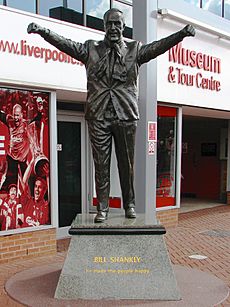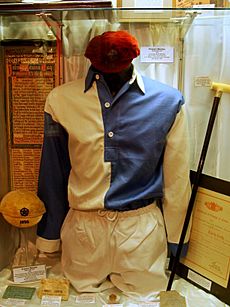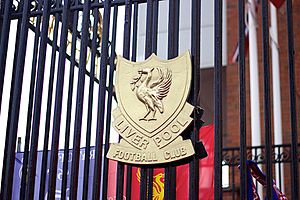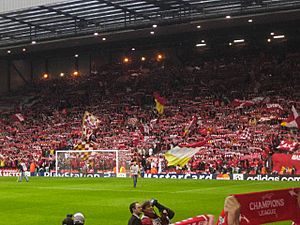Liverpool F.C. facts for kids
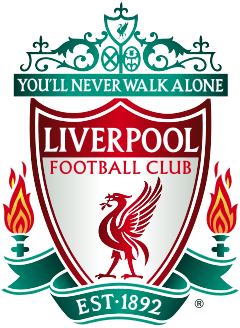 |
||||
| Full name | Liverpool Football Club | |||
|---|---|---|---|---|
| Nickname(s) | The Reds | |||
| Founded | 3 June 1892 | |||
| Ground | Anfield | |||
| Capacity | 61,276 | |||
| Owner | Fenway Sports Group | |||
| Chairman | Tom Werner | |||
| Head coach | Arne Slot | |||
| League | Premier League | |||
| 2018–19 | Premier League, 2nd of 20 (champions) | |||
|
||||
Liverpool Football Club is a famous football club from Liverpool, England. They play in the Premier League, which is the top football league in England. The club started in 1892 and has played its home games at Anfield ever since. Liverpool is known as one of the biggest and most supported football clubs in the world.
Liverpool has won many important trophies. They have won the English league title a record twenty times. They also have eight FA Cups, a record ten League Cups, and sixteen FA Community Shields. In international games, they have won six European Cups, three UEFA Cups, and four UEFA Super Cups. These are all English records. They have also won one FIFA Club World Cup.
The club became very strong in the 1960s under manager Bill Shankly. Later, managers like Bob Paisley, Joe Fagan, and Kenny Dalglish helped them win many league titles and European Cups in the 1970s and 80s. Liverpool won two more European Cups in 2005 and 2019 with managers Rafael Benítez and Jürgen Klopp. Klopp also led them to their nineteenth league title in 2020. After Klopp left in 2024, Arne Slot became manager and led Liverpool to their twentieth league title in 2025.
The team is nicknamed the Reds because they wear all-red home kits. This tradition started with Bill Shankly. The club's famous song is "You'll Never Walk Alone". Liverpool has a big local rivalry with Everton, called the Merseyside derby. They also have a strong rivalry with Manchester United, as both are very successful English clubs.
Liverpool supporters have been affected by two major stadium events. In 1985, at the 1985 European Cup final in Brussels, a wall collapsed, leading to the deaths of 39 fans. This event, known as the Heysel Stadium disaster, resulted in English teams being banned from European competitions for five years. In 1989, the Hillsborough disaster caused the deaths of 97 Liverpool supporters due to overcrowding. This led to important changes in stadium safety, making all top-tier stadiums all-seater. A long campaign for justice for Hillsborough fans showed that the fans were not to blame.
Contents
Club History
Early Years and First Trophies
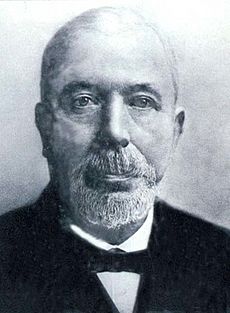
Liverpool Football Club was started because of a disagreement. The Everton team committee had a problem with John Houlding. He was the club president and owned the land where their stadium, Anfield, was located. After playing at Anfield for eight years, Everton moved to a new stadium called Goodison Park in 1892.
With an empty stadium, John Houlding decided to create a new team to play at Anfield. This new team was Liverpool F.C. They played their first game on September 1, 1892, winning 7–1 against Rotherham Town. The team was made up entirely of Scottish players, who were sometimes called "Scotch Professors."
Liverpool won the Lancashire League in their first season. They then joined the Football League Second Division in 1893. After being promoted to the First Division in 1896, Tom Watson became manager. He led Liverpool to their first league title in 1901 and another in 1906.
The club reached its first FA Cup final in 1914 but lost. They won league championships again in 1922 and 1923. After a long wait, they won the First Division for the fifth time in 1947. Liverpool was relegated to the Second Division in 1954.
Shankly and the Boot Room Era
In 1959, Bill Shankly became manager. He made big changes, letting go of many players and creating a special "Boot Room" where coaches planned strategies. Shankly, along with Joe Fagan, Reuben Bennett, and Bob Paisley, rebuilt the team.
Liverpool was promoted back to the First Division in 1962. They won the league title in 1964, their first in 17 years. In 1965, they won their first FA Cup. The next year, they won the First Division again.
Liverpool won the League and the UEFA Cup in 1973, and the FA Cup in 1974. Shankly retired soon after, and his assistant, Bob Paisley, took over.
Paisley's Golden Age
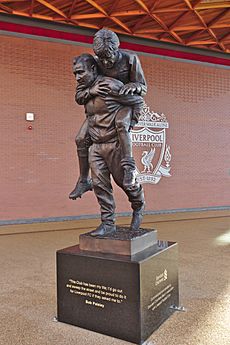
Bob Paisley's time as manager was incredibly successful. In 1976, Liverpool won the League and UEFA Cup. The next season, they won the League title again and the European Cup for the first time. They won the European Cup again in 1978 and the First Division title in 1979.
During his nine seasons, Paisley led Liverpool to 20 trophies. This included three European Cups, a UEFA Cup, six League titles, and three League Cups. He is the most successful manager in the club's history.
Tragedies and Changes
Paisley retired in 1983, and Joe Fagan became manager. In his first season, Liverpool won the League, League Cup, and European Cup. This made them the first English team to win three major trophies in one season.
In 1985, Liverpool reached the European Cup final against Juventus at the Heysel Stadium. Before the game, a terrible event happened where a wall collapsed, and 39 fans died. This was the Heysel Stadium disaster. English clubs were banned from European competitions for five years because of this. Liverpool was banned for an extra year.
Joe Fagan retired after the disaster, and Kenny Dalglish became player-manager. Under Dalglish, the club won three more league titles and two FA Cups. However, another tragedy occurred in 1989 at the Hillsborough disaster. During an FA Cup semi-final, 97 Liverpool fans died due to overcrowding. This led to new rules that required all top-division stadiums to have only seats, no standing areas. Investigations later showed that police control failures were the main cause of the disaster.
Modern Era and Recent Success
Dalglish left in 1991 and was replaced by Graeme Souness. Liverpool won the 1992 FA Cup final under him. Later, Roy Evans and then Gérard Houllier managed the team. In 2001, Houllier led Liverpool to win the FA Cup, League Cup, and UEFA Cup in one season.
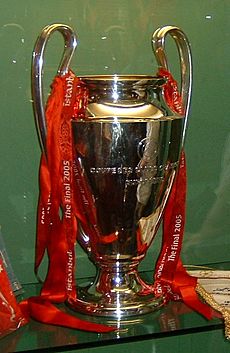
Rafael Benítez became manager in 2004. In his first season, Liverpool won the 2004–05 UEFA Champions League, beating AC Milan in a thrilling final. They also won the FA Cup in 2006.
In 2010, Fenway Sports Group became the new owners of the club. Brendan Rodgers became manager in 2012 and led the team to a strong second-place finish in the league in 2014.

Jürgen Klopp took over as manager in 2015. Under him, Liverpool reached the finals of the League Cup and Europa League in his first season. In 2019, they won the UEFA Champions League again, beating Tottenham Hotspur. They also won the FIFA Club World Cup for the first time that year.
In the 2019–20 season, Liverpool won their first top-flight league title in thirty years. They set many records that season, including winning the league with seven games left. In the 2021–22 season, they won both the FA Cup and the League Cup. Jürgen Klopp announced he would leave in January 2024, winning his final trophy, the League Cup, the next month.
Arne Slot became the new manager, and in his first season, the club won a record-equalling twentieth top-flight league title in 2025.
Team Colours and Badge
For most of Liverpool's history, their home kit has been all red. When the club started in 1892, they wore blue and white shirts. But in 1896, they changed to red, which is the colour of the city.
The club's badge, or crest, features the liver bird, a symbol of Liverpool city. This symbol was added to the badge in 1901 and appeared on the kit in 1955.
In 1964, manager Bill Shankly decided the team should wear all red. He believed red looked powerful and dangerous. Player Ian St John remembered Shankly saying, "Christ, Ronnie, you look awesome, terrifying. You look 7 ft tall." This led to the iconic all-red kit.
Away kits have often been yellow or white shirts with black shorts. Over the years, there have been different colours like grey, green, gold, and navy. A third kit is sometimes used for European away games or when the away kit clashes with another team's colours.
Many different companies have made Liverpool's kits over the years, including Umbro, Adidas, Reebok, Warrior Sports, New Balance, and currently Nike. In 2025, the club will reunite with Adidas.
Liverpool was the first English professional club to have a sponsor's logo on its shirts, starting with Hitachi in 1979. Other sponsors have included Crown Paints, Candy, Carlsberg, and currently Standard Chartered.
The club's badge has changed over time. In 1992, for the club's 100th birthday, a new badge was made that included the Shankly Gates. The next year, two flames were added to the sides. These flames represent the memorial outside Anfield for those who died in the Hillsborough disaster. Since 2022, the number 97 has been included on the back collar of the shirt, remembering the 97 people who died at Hillsborough.
Anfield Stadium
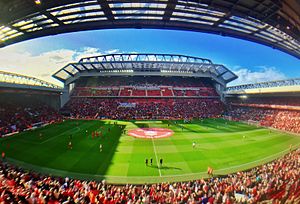
Liverpool's home stadium is Anfield. It was built in 1884 and is about 2 miles (3.2 km) from Liverpool city centre. Anfield was first used by Everton. But after a disagreement over rent, Everton moved, and John Houlding started Liverpool F.C. to play there. The stadium could hold 20,000 people when it first opened.
The Kop Stand
The Kop is a famous part of the stadium where Liverpool's most passionate fans, called "Kopites," gather. It was originally a standing area but is now all-seated. The Kop is known as the heart of Anfield's fan base. It was built in 1906 and named after a hill in South Africa called Spion Kop. Many soldiers from Liverpool died there during a war.
At its largest, the Kop could hold 28,000 fans. It was one of the biggest single-tier stands in the world.
Stadium Upgrades
Anfield used to hold over 60,000 fans. But in the 1990s, new safety rules after the Hillsborough disaster required all top-tier stadiums to have seats only. This reduced Anfield's capacity to 45,276.
To increase capacity, the Kemlyn Road Stand was rebuilt in 1992 and renamed the Sir Kenny Dalglish Stand in 2017. An extra level was added to the Anfield Road end in 1998.
For a while, Liverpool considered building a new stadium. But in 2012, the club's new owners, Fenway Sports Group, decided to expand Anfield instead. The Main Stand was redeveloped, increasing the capacity to 54,074. This was part of a big project to improve the Anfield area.
In 2021, plans were approved to expand the Anfield Road stand further. This will add about 7,000 more seats, bringing the total capacity to 61,276. The first league game with over 60,000 fans after this expansion was on March 31, 2024.
Fan Support
Liverpool has one of the largest fan bases in the world. The club has over 300 official fan clubs in 100 countries. Fans often call themselves Kopites, named after the famous Kop stand at Anfield.
The club's anthem is "You'll Never Walk Alone". This song, originally from a musical, has been sung by the Anfield crowd since the 1960s. It's a very important part of Liverpool's identity. The song's title is even written on the Shankly Gates outside the stadium, which honour former manager Bill Shankly.
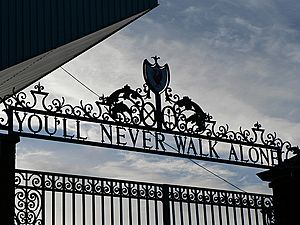
Liverpool fans have been involved in two major stadium events. The 1985 Heysel Stadium disaster in Brussels led to the deaths of 39 people. The 1989 Hillsborough disaster in Sheffield caused the deaths of 97 Liverpool fans due to overcrowding. These events led to significant changes in football stadium safety and a long fight for justice for the victims and their families.
Club Rivalries
Liverpool has two main rivalries. The first is with their local neighbours, Everton. This is called the Merseyside derby. It started when Liverpool F.C. was formed after a disagreement with Everton. This derby is known for being intense, with many players getting sent off in games.
The second major rivalry is with Manchester United. This rivalry comes from the historical competition between the cities of Liverpool and Manchester. Both clubs are the most successful English teams in history and have huge fan bases worldwide. They are considered one of the biggest rivalries in football.
Club Officials
Fenway Sports Group and FSG International
Liverpool Football Club
|
Coaching and Medical Staff
|
Club Honours
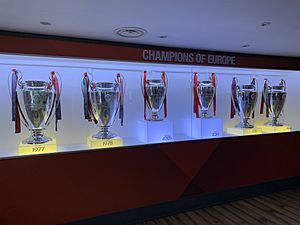
Liverpool won its first trophy, the Lancashire League, in its very first season. Their first League title was in 1901. Their most recent, and record-equalling twentieth, was in 2025. They won their first FA Cup in 1965.
The 1980s were Liverpool's most successful decade for trophies. They won six League titles, two FA Cups, four League Cups, and two European Cups during that time. In 2020, Liverpool became the first English club to win a League title in eight different decades.
Liverpool holds the record for the most top-flight wins and points in English football. They also have the highest average league finishing position over the last 50 years.
Liverpool is the most successful British club in international football, with fourteen trophies. They have won the European Cup/UEFA Champions League six times, which is an English record. They also hold the English record for three UEFA Cup wins and four UEFA Super Cup wins. In 2019, they won the FIFA Club World Cup for the first time. This made them the first English club to win the Champions League, UEFA Super Cup, and Club World Cup in a "treble."
| Type | Competition | Titles | Seasons |
|---|---|---|---|
| Domestic | First Division/Premier League | 20s | 1900–01, 1905–06, 1921–22, 1922–23, 1946–47, 1963–64, 1965–66, 1972–73, 1975–76, 1976–77, 1978–79, 1979–80, 1981–82, 1982–83, 1983–84, 1985–86, 1987–88, 1989–90, 2019–20, 2024–25 |
| Second Division | 4 | 1893–94, 1895–96, 1904–05, 1961–62 | |
| FA Cup | 8 | 1964–65, 1973–74, 1985–86, 1988–89, 1991–92, 2000–01, 2005–06, 2021–22 | |
| Football League Cup/EFL Cup | 10 | 1980–81, 1981–82, 1982–83, 1983–84, 1994–95, 2000–01, 2002–03, 2011–12, 2021–22, 2023–24 | |
| FA Charity Shield/FA Community Shield | 16 | 1964*, 1965*, 1966, 1974, 1976, 1977*, 1979, 1980, 1982, 1986*, 1988, 1989, 1990*, 2001, 2006, 2022 (* shared) | |
| Football League Super Cup | 1 | 1985–86 | |
| Continental | European Cup/UEFA Champions League | 6 | 1976–77, 1977–78, 1980–81, 1983–84, 2004–05, 2018–19 |
| UEFA Cup/UEFA Europa League | 3 | 1972–73, 1975–76, 2000–01 | |
| UEFA Super Cup | 4 | 1977, 2001, 2005, 2019 | |
| Worldwide | FIFA Club World Cup | 1 | 2019 |
- record
- s shared record
Other Titles
- Lancashire League
- Winners (1): 1892–93
- Sheriff of London Charity Shield
- Winners (1): 1906
Winning Combinations
- Doubles:
- League and FA Cup (1): 1985–86
- League and League Cup (2): 1981–82, 1982–83
- League and European Cup (2): 1976–77, 1983–84
- League and UEFA Cup (2): 1972–73, 1975–76
- League Cup and European Cup (1): 1980–81
- FA Cup and League Cup (1): 2021–22
- Trebles:
- League, League Cup and European Cup (1): 1983–84
- FA Cup, League Cup and UEFA Cup (1): 2000–01
See also
 In Spanish: Liverpool Football Club para niños
In Spanish: Liverpool Football Club para niños


